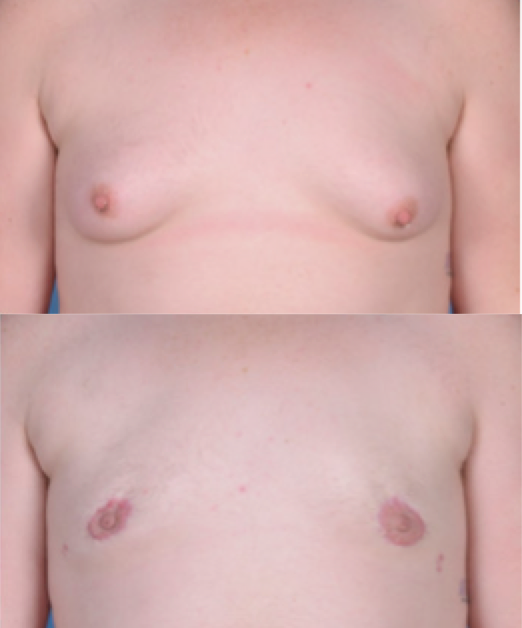Chest Wall Masculinization Using a Nipple-Areola Complex Transposition Flap in a Novel Periareolar Approach
Jordan D. Frey, M.D., Catherina C. Motosko, B.S., Grace Poudrier, B.A., Alexes Hazen, M.D..
NYU Langone Health, New York, NY, USA.
Background:
Compared to that of a female, the male nipple-areola complex is smaller, more ovoid, and more laterally positioned. The authors describe a novel periareolar approach to chest wall masculinization in transgender men using a lateral nipple transposition flap based on a superomedial pedicle.
Methods:
Patient demographics, intra-operative variables, and post-operative outcomes were collected and analyzed for all patients who underwent primary, bilateral mastectomy and chest wall reconstruction using the senior authorís periareolar technique. This group was compared to a control group of 50 patients who underwent chest wall masculinization with a double-incision mastectomy, component nipple-areola complex reconstruction technique.
Results:
Seven patients underwent 14 mastectomy and chest wall reconstructions using the authorís periareolar technique. Average age and body-mass index were 25.86 years and 23.29 kg/m2, respectively. Three patients (42.9%) were taking testosterone while two (28.6%) had a history of smoking. One patient (14.3%) had undergone prior liposuction-only breast reduction. Average follow-up was 6.39 months.
Average operative time was 151 minutes. One patient (14.3%) underwent adjunctive liposuction. Average mastectomy weight was 126.96 grams. There was one incidental finding of atypical ductal hyperplasia (7.1%) in a mastectomy specimen. Average length of hospital stay was 0.86 days.
No patients experienced immediate post-operative complications, such as nipple-areola complex loss or hematoma. Two patients (3 nipple-areola complexes; 21.4%) underwent delayed nipple reduction in the office. Two patients (4 nipple-areola complexes; 28.6%) underwent planned scar revision in the office.
Demographically, patients in the periareolar group had significantly lower body-mass indices (p=0.0128), less testosterone use (p=0.0070), lower mastectomy weights (p=0.0018), and shorter follow-up (p<0.0001) compared to the control group. There were no significant differences with regards to immediate complications. Patients in the periareolar group had significantly greater higher rates of nipple-areola complex revisions (p<0.0001). There were no differences in terms of scar revision (p=0.4498), liposuction (p=0.8524), or fat grafting (p=0.7903).
Conclusions:
The lateral nipple transposition flap based on a superomedial pedicle through a periareolar approach is a safe and effective option for transgender men seeking chest wall masculinization.
Figure 1: 25 year old shown pre-operatively (top) and post-operatively (bottom) after chest masculinization using a lateral nipple transposition flap based on a superomedial pedicle through a periareolar approach.

Back to 2018 Posters




